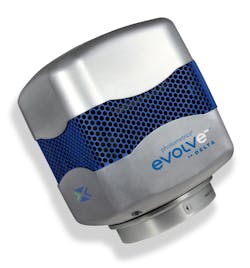The Evolve 512 Delta is a 512 × 512 pixel EMCCD camera using a sensor running at 20 MHz that captures images at 62.5 frames/s with less than 1e- read noise (using EM gain). Offering greater than 90% quantum efficiency, it is specifically designed for applications such as STORM, PALM, and GSD.
Photometrics
Tucson, AZ
www.photometrics.com
More Products
-----
PRESS RELEASE
Photometrics® Launches Industry’s Fastest, Most Sensitive 512x512 EMCCD Camera for Super-Resolution Imaging
The Evolve™ 512 Delta Acquires Data in Half the Time of Previous Cameras
Tucson, AZ (PRWEB) - Photometrics introduces another first in EMCCD technology with its new Evolve 512 Delta EMCCD camera. The Evolve 512 Delta possesses the industry’s fastest frame rates and highest sensitivity for a camera of its class, enabling researchers to obtain high quality super-resolution images in half the time it takes other 512x512 EMCCD cameras on the market.
For super-resolution experiments to be successful, researchers need a camera capable of collecting data at extremely high frame rates. While the optical components for super-resolution imaging have improved, camera technology remains limited by its speed, creating a bottleneck. Equipped with a sensor running at 20MHz that captures images at 62.5 frames per second and less than 1e- read noise (using EM gain), the Evolve 512 Delta makes super-resolution imaging much more productive and efficient.
The Evolve 512 Delta was specifically designed for super-resolution applications such as STORM, PALM and GSD. The camera is also suited for a range of other applications including SMF and Tracking, Live-cell Spinning Disk Confocal, SPIM, Intrinsic Imaging, FCWS, TIRF, FRET and FRAP.
Evolve 512 Delta is the only camera to offer these features and benefits:
20MHz sensor
62.5 frames per second
>90% quantum efficiency
Quantitative performance
“Photometrics recognizes the increasing demands for life science research facilities to achieve faster results with limited resources,” said Rachit Mohindra, Photometrics product manager. “The Evolve 512 Delta brings those benefits to researchers working in super-resolution and other demanding applications.”
Photometrics is providing existing Evolve 512 customers with an option to upgrade their legacy cameras to the performance level of the Evolve 512 Delta, extending the life of their investment. The upgrade package will be available through the company’s global service centers.
About Photometrics
Founded in 1978, Photometrics is the world’s premier designer and manufacturer of high-performance CCD and EMCCD cameras for life science research. The original architect of the world’s first scientific-grade microscopy EMCCD camera, Photometrics for decades has led the industry with state-of-the-art imaging instrumentation for the scientific community. Tens of thousands of researchers around the globe rely on these cutting-edge imaging systems to meet their most demanding application requirements. Photometrics also offers comprehensive OEM support, including fully characterized, cost efficient imaging systems and components that provide the best solutions for customers’ unique requirements. Photometrics is headquartered in the Tucson, Arizona in the United States. Additional information is available at http://www.photometrics.com.
-----
Follow us on Twitter
Subscribe now to Laser Focus World magazine; it's free!
